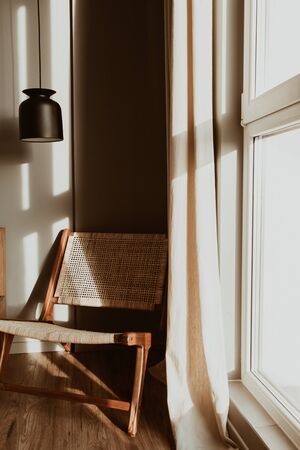Embracing Natural Light in British Homes
Living in the UK means getting used to grey skies and shorter days, especially through autumn and winter. The limited daylight can make homes feel dull and chilly, so it’s essential to find ways to maximise every drop of natural light. One effective approach is to embrace natural finishes within your home’s interior design. By using materials and colours that reflect and amplify sunlight, you can make even the gloomiest spaces feel lighter, warmer, and more inviting. Opt for pale wood floors, limewashed walls, and light-toned furnishings; these choices bounce light around a room rather than absorbing it. Consider window dressings carefully—swap heavy curtains for sheer fabrics or simple blinds that let in more light while maintaining privacy. Even small changes such as rearranging furniture to avoid blocking windows or adding mirrors to reflect daylight can make a significant difference. With thoughtful use of natural finishes, you can create a brighter and cosier atmosphere that combats Britain’s often overcast weather, turning your home into a welcoming retreat year-round.
2. The Benefits of Natural Finishes
When it comes to brightening up British homes and creating a cosy, inviting atmosphere despite the often grey skies outside, natural finishes offer both practical and aesthetic advantages. These materials, including lime wash, untreated wood, and clay paints, are increasingly favoured not just for their visual appeal but also for their positive impact on indoor environments and the planet.
Eco-Friendly Materials at a Glance
| Material | Main Properties | Contribution to Warmth & Sustainability |
|---|---|---|
| Lime Wash | Breathable, anti-bacterial, mineral-based | Allows walls to “breathe,” reduces damp issues, adds soft luminosity to rooms |
| Untreated Wood | Natural insulator, tactile warmth, ages gracefully | Enhances thermal comfort, brings nature indoors, low VOC emissions |
| Clay Paints | Non-toxic, earthy tones, moisture regulating | Improves air quality, controls humidity, creates a warm ambience with subtle hues |
The Science of Comfort in British Homes
The UK’s unpredictable weather demands interiors that manage moisture and temperature efficiently. Lime wash and clay paints are especially valuable in older British properties where solid walls need to manage condensation. Their breathability helps prevent mould—a common issue during damp winters. Untreated wood not only adds a touch of rustic charm reminiscent of countryside cottages but also acts as a natural insulator, making living spaces feel physically warmer underfoot or by touch.
Sustainability and Practical Maintenance
Choosing these materials aligns with the growing emphasis on sustainability in British construction and renovation. They are derived from renewable resources or minimally processed ingredients, reducing their carbon footprint compared to synthetic alternatives. For ongoing maintenance—a key concern in the UK’s variable climate—these finishes can be easily refreshed or repaired without specialist intervention. This not only extends the life of your surfaces but also minimises waste over time.
A Holistic Approach to Light and Warmth
Natural finishes provide more than just a surface treatment; they interact with daylight in ways that amplify brightness even when the sun is scarce. Their textures diffuse light softly across rooms and their organic colours create an uplifting sense of comfort. In essence, by embracing these time-tested materials, homeowners can achieve interiors that feel both lighter and warmer—perfect for weathering Britains long seasons with style and sustainability.

3. Techniques for Enhancing Warmth
When it comes to achieving both light and warmth in the often grey and chilly British climate, your choice of natural finishes can make a world of difference. To create a truly cosy atmosphere, its important to not only select the right materials but also to consider how they are layered and combined throughout your home.
Layering Textures for Comfort
One of the most effective ways to introduce warmth is by layering textures. Start with timber surfaces—such as oak flooring or exposed beams—which offer a natural sense of warmth underfoot and overhead. Complement these with soft furnishings made from wool, linen, or cotton; think chunky knit throws, woven rugs, and scatter cushions. This approach doesnt just add visual depth but also creates tactile comfort that feels inviting on colder days.
Selecting Warm Hues
The British weather often brings muted daylight, so opt for natural finishes in warmer tones. Honeyed woods, terracotta tiles, and clay-based paints in ochre, sage, or soft taupe reflect available light while imparting a gentle glow. Avoid stark whites or cool greys which may exacerbate the dreariness of overcast skies. Instead, embrace earthy pigments that echo the countryside—these hues work harmoniously with Britain’s traditional architecture and landscape.
Practical Application in British Homes
For listed buildings or period homes, limewash walls paired with reclaimed pine panelling strike a balance between heritage and homeliness. In modern flats, bamboo blinds alongside jute runners instantly lift a space without overwhelming it. Remember to keep maintenance in mind: oil wooden surfaces regularly to preserve their sheen and use breathable finishes to allow older properties to ‘breathe’ through damp spells.
By thoughtfully combining these techniques—layering textures and choosing warm, natural hues—you’ll ensure your interiors remain inviting and comfortable no matter how gloomy the forecast.
4. Traditional British Methods Meets Modern Design
In the quest to achieve light and warmth in homes across the UK, there has been a notable resurgence of time-honoured British maintenance and finishing techniques. These methods—such as lime plastering, traditional wood oils, and natural stone finishes—are now being integrated with modern design sensibilities to create interiors that are both practical for Britain’s often gloomy weather and aesthetically pleasing.
The Revival of Lime Plastering
Lime plastering, once a staple in heritage properties, is regaining popularity due to its breathability, flexibility, and ability to regulate moisture. Unlike cement-based products, lime allows walls to “breathe,” minimising damp issues commonly found in older British homes. When paired with contemporary colour palettes or minimalist furnishings, lime plaster creates an inviting softness that amplifies available light.
Comparing Traditional and Modern Finishing Approaches
| Technique | Main Benefits | Modern Applications |
|---|---|---|
| Lime Plastering | Moisture regulation, soft texture, environmental friendliness | Paired with open-plan layouts and large windows for brighter spaces |
| Natural Wood Oils | Enhanced grain visibility, protective finish | Used on engineered floors or accent walls for warmth and character |
| Stone Finishes | Durability, timeless appearance | Feature walls or fireplace surrounds in contemporary settings |
Blending Old with New for Lasting Comfort
The fusion of traditional British finishes with modern interior trends is not simply an aesthetic choice—it is also rooted in practical benefits. Natural materials tend to perform well against the damp, cold conditions typical of the UK climate. By combining classic craftsmanship with today’s design innovations, homeowners are able to enjoy spaces that feel lighter, warmer, and more connected to Britain’s architectural heritage while benefiting from the comforts of modern living.
5. Maintenance and Upkeep in Damp Climates
Natural finishes can bring inviting warmth and brightness to homes, yet Britains signature dampness presents unique challenges for their upkeep. To maintain both the beauty and performance of natural materials, homeowners must adopt a proactive approach tailored to the UK’s often wet and unpredictable weather.
Protecting Against Moisture
Persistent moisture is a prime culprit in degrading natural finishes—causing swelling, mould growth, and discolouration. Regularly inspect walls, floors, and woodwork for early signs of damp patches or condensation. Ensure adequate ventilation by keeping trickle vents open and using extractor fans in kitchens and bathrooms. In older properties, consider the installation of breathable insulation or vapour barriers that won’t trap moisture within walls.
Routine Care Recommendations
Dust and clean surfaces frequently with soft, dry cloths to prevent dirt from embedding into porous finishes. When deeper cleaning is necessary, use pH-neutral cleaners specifically formulated for natural materials like limewash or untreated timber—avoid harsh chemicals that may strip protective layers. For wooden elements, periodically reapply natural oils or waxes; this not only nourishes the material but also enhances its resistance to ambient dampness.
Treating Mould and Minor Damage
If you spot mould or mildew, act swiftly. Wipe affected areas with a diluted vinegar solution or a commercial product suitable for natural surfaces—always test on an inconspicuous spot first. Sand down minor water marks on timber before resealing with oil. For lime-plastered walls, touch up any cracks with compatible filler to prevent further ingress of moisture.
Seasonal Checks for Longevity
As British weather shifts between wet winters and mild summers, plan seasonal inspections of your home’s natural finishes. Look out for joint movement in woodwork or hairline cracks in plaster after cold snaps. Promptly address gutter leaks or blocked downpipes that can cause localised damp problems inside. By staying vigilant and performing small maintenance tasks regularly, you’ll ensure your home remains bright, warm, and resilient throughout the year.
6. Case Studies: Real Homes Across the UK
Bringing Light into a Victorian Terrace, Manchester
In the heart of Manchester, where grey skies are all too common, the owners of a classic Victorian terrace have embraced natural lime plaster for their interior walls. By opting for a soft, warm-white finish and pairing it with stripped pine floorboards, they report a significant improvement in light levels and overall warmth. The homeowners found that the breathable nature of lime helped mitigate persistent damp issues typical of older brick constructions. According to local restoration specialist Sarah Jennings, “The use of lime not only brightens rooms but actively manages moisture, making these spaces healthier and far more inviting.”
Revitalising a Cottage in Cornwall
Down in Cornwall, where Atlantic mists can leave interiors feeling cold and dull, one couple transformed their granite cottage by applying clay-based paints to the walls and ceilings. Their choice of natural pigments—ochres and soft creams—reflects available daylight and creates a cosy atmosphere even during stormy spells. The couple also installed reclaimed timber beams finished with linseed oil, adding both character and an extra sense of warmth. Feedback from their local builder highlighted how natural finishes have reduced condensation and preserved the historic fabric of the home.
A Modern Eco-Home in Glasgow
In Glasgow’s suburbs, a new-build eco-home uses natural finishes as a core design principle. The architect specified sheep’s wool insulation combined with exposed clay plaster walls tinted with British earth pigments. Homeowner testimonials emphasise how these finishes maintain a consistent temperature and brightness throughout gloomy winter months. According to sustainability consultant Fiona Murray, “Natural finishes support both comfort and energy efficiency—key considerations for homes facing Scotland’s lengthy wet seasons.”
Insights from Professionals
Across these case studies, professionals stress that selecting the right natural finish is crucial for each property type and local climate conditions. They note that while application methods may differ between stone cottages and urban terraces, the benefits—healthier air quality, reduced maintenance needs, and enhanced luminosity—are universal. Homeowners consistently remark on the improved mood and well-being resulting from brighter, drier living spaces.
Conclusion: Lessons from Real Homes
The experiences of households across Britain demonstrate that natural finishes are not only aesthetically pleasing but also provide practical solutions for combating gloom and dampness. These case studies offer inspiration for anyone looking to bring more light and warmth into their home, proving that thoughtful material choices can transform even the most challenging British interiors.

